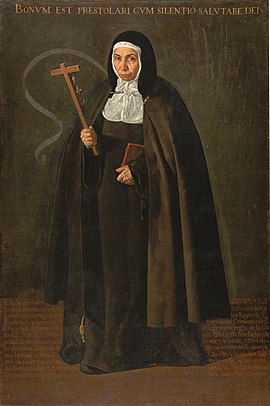The Nun Jerónima de la Fuente
| The Nun Jerónima de la Fuente | |
|---|---|
 | |
| Artist | Diego Velázquez |
| Year | 1620 |
| Type | Oil on canvas |
| Dimensions | 160 cm × 110 cm (63 in × 43 in) |
| Location | Museo del Prado, Madrid, Spain |
| Website | at Museo del Prado |
The Nun Jerónima de la Fuente is a full-length
History

First discovered at an exhibition in 1926, the painting was originally attributed to Luis Tristán.[2] Upon restoration, however, Diego Velázquez's signature surfaced.[2] Velázquez painted Jerónima in June 1620[3] during Jerónima de la Asunción's two-month stop-over in Seville, Spain en route to the Philippines.[2][4] The painting was commissioned by one of the Franciscans accompanying Jerónima or Alvaro de Villegas, the vicar of the Santa Isabel convent in Toledo.[5]
Jerónima is one of the earliest known portraits by Velázquez,
Description
Velázquez's portrait depicts Jeronima standing against a dark background while holding a small book in her left hand and grasping a wooden
In painting Jerónima, Velázquez was heavily influenced by his father-in-law and mentor Francisco Pacheco.[10] The painting is noted for its "tight brushstrokes"[6] and "Caravaggiesque use of chiaroscuro with powerful characterizations and a crude light that unforgivingly emphasizes the irregularities of her face and hands",[2] which reflects his preference for realism prior to his relocation to Madrid.[7] The painting creates a "sacred image" that is "filled with truth while creating an exemplary model of sainthood".[2] Velázquez also based his painting on several local depictions of Franciscan saints and other notable figures including Elizabeth of Portugal and Clare of Assisi, plus some of Pacheco's own paintings.[11]
Significance
Velázquez's painting is significant in detailing the nun's aged physical features while simultaneously capturing her sainthood.
See also
References
- JSTOR 1483604.
- ^ a b c d e f g "The Nun Jerónima de la Fuente". Museo del Prado. Retrieved 20 May 2018.
- ^ Lopez-Rey, Jose (1979). Velázquez, the Artist as a Maker: With a Catalogue Raisonné of His Extant Works. Bibliothéque des Arts. p. 223.
- ^ Tiffany 2012, p. 56.
- ^ a b Tiffany 2012, p. 59.
- ^ a b c Tiffany 2012, p. 49.
- ^ a b c Tiffany 2012, p. 51.
- ^ Tiffany 2012, p. 57.
- JSTOR 1358490.
- ^ Tiffany 2012, p. 63.
- ^ a b Tiffany 2012, p. 66.
- ^ Tiffany 2012, p. 60.
- ^ Tiffany 2012, p. 68.
- ^ Tiffany 2012, p. 70.
- ^ Tiffany 2012, p. 71.
- ^ Tiffany 2012, p. 72.
Bibliography
- Tiffany, Tanya J. (2012). Diego Velázquez's Early Paintings and the Culture of Seventeenth-century Seville. Penn State Press. ISBN 9780271053790.
